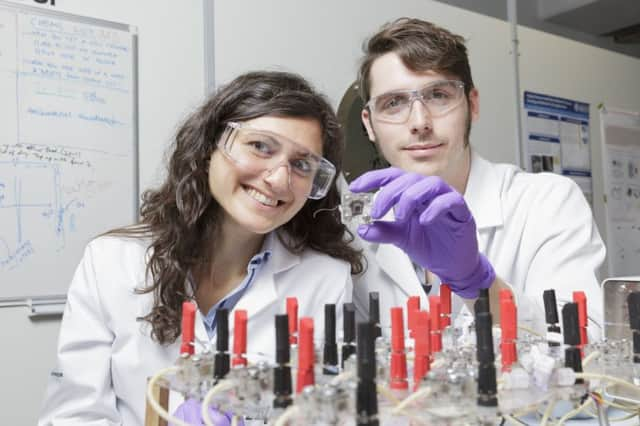Tiny fuell cell uses urine to generate electricity


The device, a microbial fuel cell, could be used to create a renewable and carbon-neutral way of generating power to remote areas at very little cost.
Each of the fuel cells, developed by researchers at the University of Bath, Queen Mary University of London and the Bristol Bioenergy Centre, costs £1 to £2.
Advertisement
Hide AdAdvertisement
Hide AdMicrobial fuel cells use natural biological processes of “electric” bacteria to turn organic matter, such as urine, into electricity.
Urine passes through the microbial fuel cell for this reaction to happen, with the bacteria then generating electricity.
This can be stored or used to directly power electrical devices. Researchers say this new kind of microbial fuel cell is smaller, more powerful and cheaper than other similar devices.
The fuel cell measures just one inch square in size and uses a carbon catalyst at the cathode which is derived from glucose and ovalbumin, a protein found in egg white.
This catalyst is a renewable and much cheaper alternative to platinum, which is commonly used in other microbial fuel cells.
Dr Mirella di Lorenzo, lecturer at the University of Bath’s department of chemical engineering, said: “If we can harness the potential power of this human waste, we could revolutionise how electricity is generated.
“Microbial fuel cells can play an important role in addressing the triple challenge of finding solutions that support secure, affordable and environmentally sensitive energy, known as the ‘energy trilemma’.
“There is no single solution to this ‘energy trilemma’ apart from taking full advantage of available indigenous resources, which include urine.” The researchers worked on the cell’s design to maximise the power that could be generated.
Advertisement
Hide AdAdvertisement
Hide AdBy increasing the cell’s electrodes from 4mm to 8mm, the power output was increased tenfold. The power was proportionally increased when the researchers stacked multiple units together.
Currently, a single microbial fuel cell can generate two watts per cubic metre, enough to power a device such as a mobile phone.
Research team members are now looking at ways of improving the power output of the microbial fuel cells and believe they will be able to increase the cell’s performance by optimising its design.
PhD student Jon Chouler, the lead author of the study, said: “Microbial fuel cells could be a great source of energy in developing countries, particularly in impoverished and rural areas.
“To have created technology that can potentially transform the lives of poor people who don’t have access to or cannot afford electricity is an exciting prospect.
“I hope this will enable those in need to enjoy a better quality of life as a result of our research.”